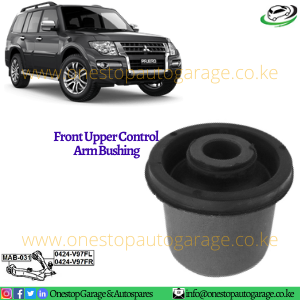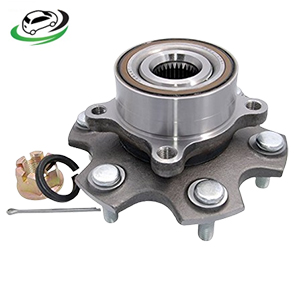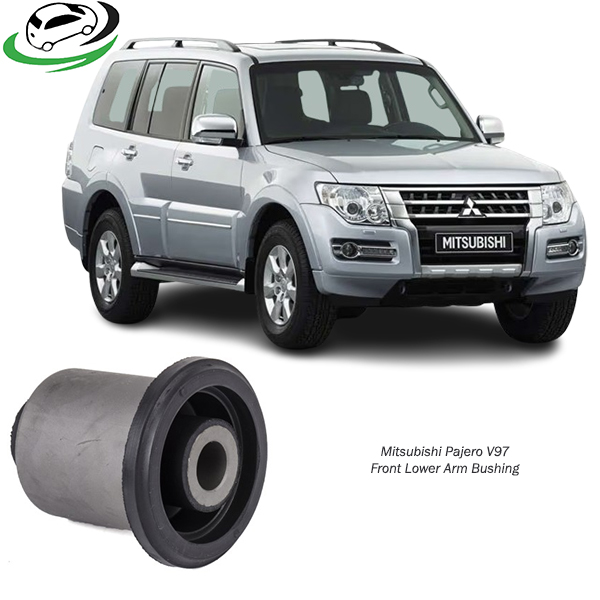-25%
Get Mitsubishi Pajero V97 / V87 Front Lower Arm Bushing
The front lower arm bushing, often referred to simply as the “control arm bushing,” is a vital component in a vehicle’s suspension system. Located between the control arm and the vehicle’s frame, this bushing absorbs shock and vibration, allowing smooth vehicle handling while keeping the wheels aligned with the road. Without properly functioning bushings, a car’s stability, handling, and comfort could be severely compromised, impacting safety and driving experience.
2. Understanding the Suspension System and the Role of Bushings
The suspension system is a complex arrangement of components that ensure the vehicle remains stable, even on rough terrain. Key parts of the system include:
- Control Arms: These metal components connect the wheel hubs to the vehicle’s frame, allowing for a controlled range of motion as the wheels move up and down.
- Shock Absorbers and Springs: These work together to dampen and manage the force from bumps, preventing it from transferring excessively to the car’s frame.
- Bushings: Typically made from rubber or synthetic compounds, bushings act as cushioning points where parts like control arms meet the frame, providing both flexibility and stability.
Front lower arm bushings specifically prevent the metal components from grinding against each other, absorbing shock and reducing noise and vibration within the cabin.
3. Primary Functions of the Front Lower Arm Bushing
The front lower arm bushing serves three main functions within the suspension system:
- Shock Absorption: By acting as a cushion between the control arm and the vehicle’s frame, bushings absorb much of the impact from uneven road surfaces, ensuring a smooth ride.
- Maintaining Alignment: Bushings help keep the wheels aligned properly with the frame and the rest of the suspension, critical for steering precision and stability.
- Reducing Noise and Vibration: The rubber material of the bushing helps to minimize noise and vibration from the road, making the drive quieter and more comfortable for passengers.
4. Structure and Composition of Front Lower Arm Bushings
Control arm bushings consist of:
- Outer Shell: Typically made of metal, this shell anchors the bushing to the control arm or frame.
- Inner Sleeve: Made of metal, the inner sleeve provides a stable point for bolting the bushing to the control arm or vehicle frame.
- Rubber or Polyurethane Core: Sandwiched between the outer shell and inner sleeve, the core material (usually rubber or polyurethane) absorbs shocks and reduces vibration. Rubber is the more common material due to its flexibility and damping qualities, while polyurethane is often chosen in performance-oriented vehicles for greater durability and reduced flex.
Each component plays a vital role, with the rubber core being essential for absorbing shocks and vibrations, while the metal shell and sleeve provide stability and a secure connection.
5. Types of Front Lower Arm Bushings
Control arm bushings vary based on design, materials, and performance requirements:
- Rubber Bushings: Rubber is the standard material, offering excellent damping qualities and flexibility. However, it wears out over time due to its soft nature.
- Polyurethane Bushings: Polyurethane is more durable and resistant to wear, often chosen for high-performance or off-road vehicles. However, it is less flexible than rubber, leading to a stiffer ride.
- Hydraulic Bushings: These contain a fluid-filled chamber for additional shock absorption, common in luxury and performance vehicles for enhanced comfort.
Each type has distinct advantages depending on the driving conditions and the driver’s priorities regarding comfort versus performance.
6. Benefits of Front Lower Arm Bushings
The benefits of a properly functioning front lower arm bushing extend beyond just vehicle comfort:
- Enhanced Vehicle Stability: By maintaining a stable connection between the control arm and the frame, bushings contribute to improved stability, especially on rough or uneven surfaces.
- Improved Handling and Steering Control: A stable control arm helps ensure that the wheels stay aligned, enhancing steering control and making the vehicle more responsive.
- Increased Comfort: Bushings absorb shocks and minimize vibrations, providing a smoother and quieter ride for passengers.
- Prolonged Tire Life: Proper alignment and reduced road shock protect tires from uneven wear, extending their lifespan.
- Reduced Maintenance Costs: With bushings absorbing much of the impact, other suspension components experience less wear and tear, reducing the need for frequent repairs or replacements.
7. Symptoms of Worn or Damaged Front Lower Arm Bushings
Bushings experience wear over time due to continuous exposure to road stress, heat, and other elements. Common signs of worn or damaged bushings include:
- Clunking or Knocking Noises: When bushings are worn, the metal parts of the suspension can make direct contact, creating clunking or knocking sounds, especially when driving over bumps or during turns.
- Uneven Tire Wear: Misalignment due to worn bushings can cause uneven tire wear, often noticeable as excess wear on one side of the tire.
- Loose or Unstable Steering: Worn bushings can cause the control arms to move excessively, making steering feel loose or less responsive.
- Excessive Vibration: As bushings wear down, their ability to absorb shocks diminishes, leading to increased vibration that can be felt in the cabin or steering wheel.
- Vehicle Drifts or Pulls: Worn bushings can affect wheel alignment, causing the vehicle to drift or pull to one side.
8. Maintenance Tips for Front Lower Arm Bushings
To maximize the lifespan and performance of bushings, regular maintenance and care are essential. Here are some useful maintenance tips:
- Regular Inspections: Have the bushings inspected during routine maintenance, especially if you frequently drive on rough roads or experience symptoms of wear.
- Avoid Rough Driving Conditions: Excessive impact and rough terrain accelerate bushing wear, so try to avoid bumpy roads or off-road conditions when possible.
- Proper Lubrication: Some bushings, especially polyurethane types, benefit from lubrication to reduce friction and prevent squeaking. Ensure the right lubricant is used, as some materials are sensitive to certain oils or greases.
- Replace in Pairs: For balanced performance, replace bushings on both sides simultaneously, even if only one is visibly worn or damaged.
- Monitor Alignment and Tire Condition: Misalignment often indicates bushing wear, so regular alignment checks can help catch issues early. Additionally, checking tire condition can provide early clues to potential bushing problems.
9. Replacement and Installation of Front Lower Arm Bushings
Replacing front lower arm bushings is complex, requiring specialized tools and an alignment check afterward. The process generally includes:
- Lifting the Vehicle: The vehicle is safely lifted and secured to access the control arm and suspension components.
- Removing the Control Arm: The mechanic removes the control arm, taking care to detach it from both the frame and wheel assembly.
- Pressing Out the Old Bushing: A hydraulic press is typically used to remove the old bushing, especially if it is tightly fitted within the control arm.
- Installing the New Bushing: The new bushing is pressed into the control arm, and the arm is reinstalled in the vehicle with bolts tightened to specified torque settings.
- Alignment Check: After installation, a wheel alignment ensures proper handling and minimizes stress on the new bushings.
10. Common Issues with Front Lower Arm Bushings
Front lower arm bushings, like other suspension components, are vulnerable to several issues:
- Wear from Overloading: Excess weight or driving on rough surfaces puts extra stress on bushings, leading to premature wear.
- Heat and Environmental Exposure: Exposure to extreme temperatures and harsh road chemicals (like road salt) can cause rubber bushings to crack or harden.
- Incorrect Installation: Improper installation can lead to misalignment, increased wear, or noise, so professional installation is advised.
11. Tips for Extending Bushing Longevity
To maximize the lifespan and effectiveness of bushings:
- Drive Cautiously on Rough Roads: Avoiding high speeds on rough terrain can reduce stress on bushings, preventing premature wear.
- Regular Maintenance Checks: Scheduling regular checks, especially if you notice symptoms of wear, can help catch and resolve minor issues before they worsen.
- Use High-Quality Replacement Parts: When replacing bushings, choose high-quality OEM or aftermarket options to ensure compatibility and durability.
12. Conclusion
Front lower arm bushings are essential for smooth handling, steering control, and overall vehicle stability. By absorbing shocks and preventing metal-on-metal contact, they protect the vehicle’s suspension system and ensure a comfortable, controlled ride. With regular inspections, cautious driving, and timely replacements, front lower arm bushings can serve effectively, enhancing safety, prolonging tire life, and reducing maintenance costs. Maintaining the bushings not only ensures reliable handling but also preserves the integrity of the entire suspension system, contributing to a smoother, safer driving experience.
Follow us on Facebook for more parts.



